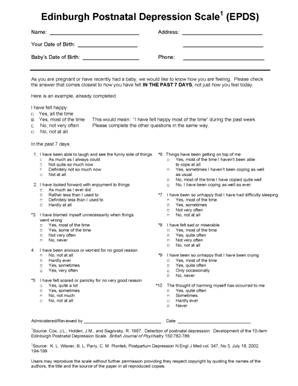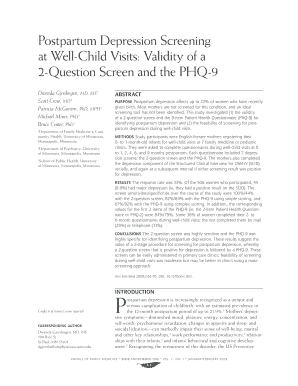
What is antenatal and postnatal depression? When to screen for postpartum depression? How can I get rid of my postnatal depression? How to help someone with postpartum depression?

Postnatal Depression Scale ( EPDS ) is a valuable and effici ent way of identifying patients at risk for “perinatal” depression. The American College of Obstetricians and Gynecologists (ACOG) recommends screening for postpartum depression (PPD) with a validated tool , which may reduce the duration or severity of depressive symptoms. To find postpartum depression screening tools for use by healthcare providers, please click this link. It will take you outside of our website to the MedEdPPD website, a project funded by the National Institute of Mental Health.
For more in-depth information, including algorithms. Clinicians might consider this when choosing a screening tool that best fits into the scope of their practices. EDINBURGH POSTNATAL DEPRESSION SCALE (EPDS) The EPDS was developed for screening postpartum women in outpatient, home visiting settings , or at the –week postpartum examination. It has been utilized among numerous populations including U. Spanish speaking women in other countries.
Because of the cross-sectional study design, infant age at the time of the maternal interview was used to assign subjects to a postpartum group to assess the screening tools’ accuracy at different points in the postpartum year: weeks to months (Early), to months (Middle), and to months (Late). Several screening instruments have been validated for use during pregnancy and the postpartum period to assist with systematically identifying patients with perinatal depression (Table 1). It also has adequate sensitivity and specificity to identify depressive symptoms in the antenatal period and is useful in identifying symptoms of anxiety.
The purpose and intent of the tool is to identify women at risk to reduce to the severity and the length postpartum depression though early and effective treatment. A careful clinical assessment should be carried out to confirm a diagnosis. The scale will not detect patients with anxiety neuroses, phobias or personality disorders. Center for Epidemiological Studies—Depression Scale. The EPDS is not a diagnostic tool and must always be used in conjunction with clinical assessment.

The Geriatric Depression Scale (GDS) is suitable for older patients. The Cornell Scale for Depression in Dementia (CSDD) is suitable for patients with dementia. This is not intended to provide a diagnosis – only trained health professionals should do this. About to of women experience clinically significant depressive symptoms during pregnancy.
Postpartum Depression Screening Consider making universal screening an essential part of your practice —for the well-being of your patient and her baby. Billing should occur under child’s MA number. PHQ-may not be billed. This screening tool is user-friendly, easy to administer and easy to score.

This is a 10-item, assessment tool that is valid and reliable for detecting postpartum depression. A screening programme for postnatal depression is not recommended. The development of postnatal depression is complex.
There is a lack of clarity on the population to be identified by screening and evidence that the use of current screening tools cannot identify risk with sufficient accuracy. Symptoms are present for most of the day and last for at least weeks. The STAR Center resources focus on early childhood screening.
For best , it is recommended that users review available instruction manuals prior to administering, scoring, and analyzing of the scoring tools. The amount of time that it takes to complete screening and scoring will vary. Availability of a tool in multiple languages does not correlate to validation of the tool in such languages.
No comments:
Post a Comment
Note: Only a member of this blog may post a comment.